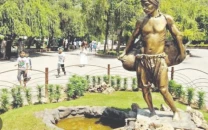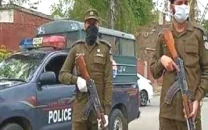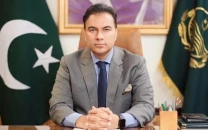Fabric of identity : Making flags for the nation
Ejaz has been producing flags for various ceremonies hosted at government institutions, for over 45 years
1610315528-0-(1)1610352988-0/Image-from-iOS-(20)1610315528-0-(1)1610352988-0-640x480.webp)
Flags have been around for thousands of years, serving as a form of identification for most civilisations, dynasties, nations and colonies of the world. But where flags of today are primarily seen as symbols on a piece of fabric, earliest known records reveal that they started out as carvings on a wooden pole.
However, with the passage of time, fabric, which was introduced as a decorative item on a flag, soon became the main object rendering poles a mere hoisting accessory.
Prior to partition, the Indian-subcontinent was home to about 584 princely states, each with its own flag, representing its ambitions and values. Similarly, the region of Rawalpindi, before becoming part of present-day Pakistan, too has been the stumping-ground of various rulers. Throughout history, the city has seen the influx of several communities, including Hindus, Sikhs, Muslims and the British— each successive invasion bringing a new flag to the region.
However, with the creation of Pakistan in 1947, all flags of the past were immediately replaced with the green-white-crescent-moon-and-five-pointed-star flag representing the then Dominion of Pakistan. The same flag was later retained by the present-day Islamic Republic of Pakistan, and has since then graced every government institution in the country.
Muhammad Ejaz, a veteran flag-maker, has been operating in Rawalpindi’s historic Hathi Chowk Tin Bazaar for over 75 years. For over four and a half decade, he has also been responsible for producing national and military-agency flags for various ceremonies hosted at government institutions like the President House, The Prime Minister House as well as the International Islamic Organisation. “The skill was passed on to me by my father, who was also a flag-maker. Back then, we produced and sold home-made flags, with the help of an old sewing machine. Later, we rented a shop near Hathi Chowk and in the last 45 years, I have made flags for almost every country, except Israel,” said Ejaz.
According to the old-hand flag-maker, the standard size of most flags, including that of the United Nations, is four by six feet. A flag of such dimension can retail for anywhere between Rs500 to Rs3,000, depending on the quality of fabric and materials used in making the flag.
“However, out of all countries, the South African flag—featuring bands of red, blue, yellow, white, green and a black isosceles triangle— is the most the most complicated to make and requires over 29 metres of cloth.
Next are the flags of armed forces and government agencies, which can take two to three months to produce. While those some flags which involve use of expensive materials like gold and silver remain the most expensive,” Ejaz told The Express Tribune. “However, the local flag-making industry has been severely hit by inflation. Material prices have soared to a sky-high, while there is little demand for these artisanal products. The substandard flags coming from China have taken over much of the market today,” he added.
Published in The Express Tribune, January 11th, 2021.



















COMMENTS
Comments are moderated and generally will be posted if they are on-topic and not abusive.
For more information, please see our Comments FAQ